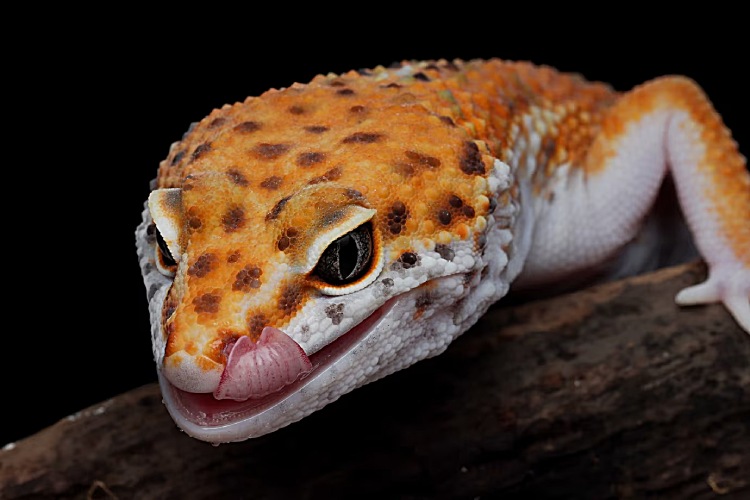How Often Do Leopard Geckoes Eat?
Do you want to know How often do leopard geckos eat? Leopard geckos are primarily insects eaters and enjoy mealworms, crickets, dubia roaches, hornworms and waxworms. They also like to eat black soldier fly larvae, superworms, which has the right calcium-to-phosphorus ratio for them.
Baby geckos should be fed every day, and then gradually reduced from 2 to 3 times per week as they get older. Be sure to coat feeder insects in a powder that contains vitamin D3 before feeding them to your leopard geckos.
How often do leopard geckos eat: Mealworms
Leopard geckos (Eublepharis macularius) are a popular reptile species for people to keep and breed as pets. They are a well-known species that can be found at many pet stores, and the good news is that they are fairly easy to care for.
They are a primarily insectivorous species and need to be fed live insects for their staple diet. This can include crickets, mealworms, dubia cockroaches, locusts, and other types of insects. You should lightly dust all of these prey insects with a calcium carbonate and multivitamin supplement to ensure they are nutritionally complete.
Mealworms are a common feeder insect, but they should not make up the bulk of your leopard gecko’s diet. They have too much fat and chitin in them, which can negatively impact your leopard gecko’s health. A mealworm only diet can also lead to metabolic bone disease, as it does not provide the proper balance of calcium to phosphorus.
How often should leopard geckos eat
Baby and juvenile leopard geckos should be fed more often than adult leopard geckos, as they are still growing and in need of more nutrition and strength. You should feed them smaller mealworms and crickets than adults, and you can also offer them a variety of other foods to help support their growth. Generally, you should feed baby and juvenile geckos 5-6 days a week with larger crickets and worms.
how often do leopard geckos eat: Crickets
Leopard geckos are primarily insectivores and should be fed a diet largely comprised of crickets. A general rule of thumb is two insects for every inch of your gecko’s length, so a four-inch long gecko would eat about eight crickets in a single meal. If you do not wish to feed your gecko crickets, you can substitute with mealworms, cockroaches or waxworms.
When feeding crickets, it is important to gut load them beforehand. This involves placing the insects in a container with a little apple or carrot for 12 hours to improve their nutritional value. This is an important step, as if the food your gecko eats does not contain enough nutrients it can lead to health problems.
In the wild, Leopard Geckos eat many insects in the same manner as they do crickets. For this reason, it is important that crickets are fed in small quantities each time, to avoid overfeeding.
If you are worried that you may be overfeeding your pet, it is recommended to keep a food diary and weigh your gecko at least once each week. This will allow you to monitor the growth and development of your animal, and spot any potential problems before they become serious.
In addition to weighing your leopard gecko, it is also important to monitor his activity levels and dietary habits to ensure that he is healthy. If you notice your pet declining his appetite, this can be a sign of illness and should be investigated by a reptile vet as soon as possible.
Waxworms
Waxworms (or wax moth larvae) are commonly bred as feeder insects for insect-eating plants, animals, amphibians and reptiles. The two most common species bred for pet shops are Achroia grisella, the lesser wax moth and Galleria mellonella, the greater wax moth. While they aren’t as nutritious as other feeder insects, some geckos find them irresistible and they can be an excellent treat or used to entice reluctant lizards to eat.
However, like crickets and mealworms, they should be given sparingly since they contain a fair amount of fat and are not nutritionally superior to other staple foods. In addition, they tend to cause intestinal blockage if fed in excess.
In many instances, they should be offered as an occasional treat for healthy adult geckos. Likewise, they can also be useful for sick or recovering geckos that need to rebuild their strength and fat stores.
Whether you’re using them as a treat or to encourage eating, it is recommended that you dust the waxworms with calcium powder before offering them to your lizard.
This can be done by pouring a small amount of the powder into your lizard’s bug dish, or dipping each individual waxworm with your tongs and coating it in the powder. This method will prevent your lizard from getting a fatty coating of the powder on their tongue and can be helpful in reducing the number of worms they are likely to discard.
Other Foods
A leopard gecko’s staple diet is a combination of crickets and mealworms. These are a must-have in any leopard gecko enclosure because they offer a full range of vitamins and minerals that your pet needs to thrive.
However, it is important to supplement these insects with a few other foods from time to time, such as waxworms, which are high in fat and can be used to add variety to the diet and boost vitamin intake, or a pinch of powdered spirulina for added protein. Whatever supplements are used, the prey must be gut-loaded and dusted with calcium and multivitamins before feeding to a Leopard Gecko.
Leopard geckos in captivity eat a few of these supplemental foods every other day or so, depending on the size of the individual and the stage of growth. Baby leopard geckos need a lot of nutrition to grow up big and strong and can consume 20 pinhead crickets in one sitting, while adults can be fed up to 10 small crickets or Dubia roaches each day.
Leopard geckos are insectivores and will never fully rely on freeze-dried food, but if they refuse to eat live foods, this could be a sign of health issues and you should consult a vet immediately. It may help to gently wiggle the live food in front of the gecko to stimulate a feeding reaction.








